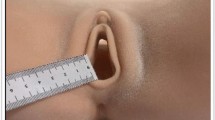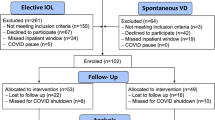Abstract
Introduction and hypothesis
Vaginal delivery may lead to levator ani muscle (LAM) injury or avulsion. Episiotomy may reduce obstetric anal sphincter injury in operative vaginal delivery, but may increase the risk of LAM injury. Our aim was to assess whether lateral episiotomy in vacuum extraction (VE) in primiparous women causes LAM injury.
Methods
A prospective cohort study of 58 primiparous women with episiotomy nested within an ongoing multicenter randomized controlled trial of lateral episiotomy versus no episiotomy in VE (EVA trial) was carried out in Sweden. LAM injury was evaluated using 3D endovaginal ultrasound 6–12 months after delivery and Levator Ani Deficiency (LAD) score. Episiotomy scar properties were measured. Characteristics were described and compared using Chi-squared tests. We stipulated that if a lateral episiotomy cuts the LAM, ≥50% would have a LAM injury. Among those, ≥50% would be side specific. We compared the observed prevalence with a test of one proportion.
Results
Twelve (20.7%, 95% CI 10.9–32.9) of 58 women had a LAD (p < 0.001, compared with the stipulated 50%). Six (50.0%, 95% CI 21.1% to 78.9%) of 12 women had a LAD on the episiotomy side, including those with bilateral LAD (p = 1.00). Two (16.7%, 95% CI 2.1% to 48.4%) of 12 women had a LAD exclusively on the episiotomy side (p = 0.02).
Conclusions
There was no excessive risk of cutting the LAM while performing a lateral episiotomy. LAD was not seen in women with episiotomies shorter than 18 mm.



Similar content being viewed by others
References
Lund NS, Persson LK, Jango H, Gommesen D, Westergaard HB. Episiotomy in vacuum-assisted delivery affects the risk of obstetric anal sphincter injury: a systematic review and meta-analysis. Eur J Obstet Gynecol Reprod Biol. 2016;207:193–9.
Sultan AH, Thakar R, Ismail KM, Kalis V, Laine K, Räisänen SH, et al. The role of mediolateral episiotomy during operative vaginal delivery. Eur J Obstet Gynecol Reprod Biol. 2019;240:192–6.
Eogan M, Daly L, O'Connell PR, O'Herlihy C. Does the angle of episiotomy affect the incidence of anal sphincter injury? BJOG. 2006;113(2):190–4.
Jiang H, Qian X, Carroli G, Garner P. Selective versus routine use of episiotomy for vaginal birth. Cochrane Database Syst Rev. 2017;2:CD000081.
Lima CTS, Brito GA, Karbage SAL, Bilhar APM, Grande AJ, Carvalho FHC, et al. Pelvic floor ultrasound finds after episiotomy and severe perineal tear: systematic review and meta-analysis. J Matern Fetal Neonatal Med. 2020. https://doi.org/10.1080/14767058.2020.1786049.
Tracy PV, DeLancey JO, Ashton-Miller JA. A geometric capacity-demand analysis of maternal levator muscle stretch required for vaginal delivery. J Biomech Eng. 2016;138(2):021001.
Thibault-Gagnon S, Yusuf S, Langer S, Wong V, Shek KL, Martin A, et al. Do women notice the impact of childbirth-related levator trauma on pelvic floor and sexual function? Results of an observational ultrasound study. Int Urogynecol J. 2014;25(10):1389–98.
Rusavy Z, Paymova L, Kozerovsky M, Veverkova A, Kalis V, Kamel RA, et al. Levator ani avulsion: a Systematic evidence review (LASER). BJOG. 2021;129(4):517–28.
Friedman T, Eslick GD, Dietz HP. Delivery mode and the risk of levator muscle avulsion: a meta-analysis. Int Urogynecol J. 2019;30(6):901–7.
Cassadó J, Simó M, Rodríguez N, Porta O, Huguet E, Mora I, et al. Prevalence of levator ani avulsion in a multicenter study (PAMELA study). Arch Gynecol Obstet. 2020;302(1):273–80.
Shobeiri SA, LeClaire E, Nihira MA, Quiroz LH, O'Donoghue D. Appearance of the levator ani muscle subdivisions in endovaginal three-dimensional ultrasonography. Obstet Gynecol. 2009;114(1):66–72.
Javadian P, O’Leary D, Rostaminia G, North J, Wagner J, Quiroz LH, et al. How does 3D endovaginal ultrasound compare to magnetic resonance imaging in the evaluation of levator ani anatomy? Neurourol Urodyn. 2017;36(2):409–13.
Kearney R, Sawhney R, DeLancey JOL. Levator ani muscle anatomy evaluated by origin-insertion pairs. Obstet Gynecol. 2004;104(1):168–73.
Van Delft K, Thakar R, Shobeiri SA, Sultan AH. Levator hematoma at the attachment zone as an early marker for levator ani muscle avulsion. Ultrasound Obstet Gynecol. 2014;43(2):210–7.
Jing D, Ashton-Miller JA, DeLancey JO. A subject-specific anisotropic visco-hyperelastic finite element model of female pelvic floor stress and strain during the second stage of labor. J Biomech. 2012;45(3):455–60.
Zhuang RR, Song YF, Chen ZQ, Ma M, Huang HJ, Chen JH, et al. Levator avulsion using a tomographic ultrasound and magnetic resonance-based model. Am J Obstet Gynecol. 2011;205(3):232.e1–8.
Dietz HP, Shek KL, Daly O, Korda A. Can levator avulsion be repaired surgically? A prospective surgical pilot study. Int Urogynecol J. 2013;24(6):1011–5.
Kalis V, Laine K, de Leeuw JW, Ismail KM, Tincello DG. Classification of episiotomy: towards a standardisation of terminology. BJOG. 2012;119(5):522–6.
Bergendahl S, Ankarcrona V, Leijonhufvud A, Hesselman S, Karlstrom S, Kopp Kallner H, et al. Lateral episiotomy versus no episiotomy to reduce obstetric anal sphincter injury in vacuum-assisted delivery in nulliparous women: study protocol on a randomised controlled trial. BMJ Open. 2019;9(3):e025050.
Stedenfeldt M, Pirhonen J, Blix E, Wilsgaard T, Vonen B, Oian P. Episiotomy characteristics and risks for obstetric anal sphincter injuries: a case-control study. BJOG. 2012;119(6):724–30.
Speksnijder L, Oom DMJ, Van Bavel J, Steegers EAP, Steensma AB. Association of levator injury and urogynecological complaints in women after their first vaginal birth with and without mediolateral episiotomy. Am J Obstet Gynecol. 2019;220(1):93.e1–9.
Starck M, Bohe M, Valentin L. Results of endosonographic imaging of the anal sphincter 2–7 days after primary repair of third- or fourth-degree obstetric sphincter tears. Ultrasound Obstet Gynecol. 2003;22(6):609–15.
Starck M, Bohe M, Valentin L. Effect of vaginal delivery on endosonographic anal sphincter morphology. Eur J Obstet Gynecol Reprod Biol. 2007;130(2):193–201.
Rostaminia G, Manonai J, Leclaire E, Omoumi F, Marchiorlatti M, Quiroz LH, et al. Interrater reliability of assessing levator ani deficiency with 360° 3D endovaginal ultrasound. Int Urogynecol J. 2014;25(6):761–6.
Shek KL, Dietz HP. Intrapartum risk factors for levator trauma. BJOG. 2010;117(12):1485–92.
Valsky DV, Lipschuetz M, Bord A, Eldar I, Messing B, Hochner-Celnikier D, et al. Fetal head circumference and length of second stage of labor are risk factors for levator ani muscle injury, diagnosed by 3-dimensional transperineal ultrasound in primiparous women. Am J Obstet Gynecol. 2009;201(1):91.e1–7.
Martinho N, Friedman T, Turel F, Robledo K, Riccetto C, Dietz HP. Birthweight and pelvic floor trauma after vaginal childbirth. Int Urogynecol J. 2019;30(6):985–90.
Cheng YW, Hopkins LM, Caughey AB. How long is too long: does a prolonged second stage of labor in nulliparous women affect maternal and neonatal outcomes? Am J Obstet Gynecol. 2004;191(3):933–8.
Leombroni M, Buca D, Liberati M, Falò E, Rizzo G, Khalil A, et al. Post-partum pelvic floor dysfunction assessed on 3D rotational ultrasound: a prospective study on women with first- and second-degree perineal tears and episiotomy. J Matern Fetal Neonatal Med. 2021;34(3):445–55.
Dietz HP. Ultrasound imaging of maternal birth trauma. Int Urogynecol J. 2021;32(7):1953–62.
Subramaniam N, Shek KL, Dietz HP. Imaging characteristics of episiotomy scars on translabial ultrasound: an observational study. J Ultrasound Med. 2021. https://doi.org/10.1002/jum.15915.
Dietz HP. Quantification of major morphological abnormalities of the levator ani. Ultrasound Obstet Gynecol. 2007;29(3):329–34.
Acknowledgements
We are deeply grateful to the women participating in the EVA trial and the obstetric staff who have contributed to the recruitment of study participants. We especially thank our research midwives Helen Fagraeus and Annelie Wikström, Danderyd Hospital, Stockholm, and Irina Sylve, Akademiska Hospital, Uppsala, Sweden.
Funding
This study was partly funded by the Swedish Research Council (grant number 2016-00526) and the Uppsala-Örebro Research Council (grant number RFR-939428).
Author information
Authors and Affiliations
Contributions
V. Ankarcrona: project development, data collection and analyses, result analyses, manuscript writing and editing; S. Karlström: project development, data collection and analyses, manuscript writing; S. Sylvan: result analyses, language editing, manuscript editing; M. Starck: data analyses, result analyses, manuscript editing; M. Jonsson: data collection, result analyses, manuscript editing; S. Brismar Wendel: project development, data collection and analyses, manuscript writing and editing. All authors approved the final version of the manuscript.
Corresponding author
Ethics declarations
Conflicts of interest
None.
Additional information
Publisher’s note
Springer Nature remains neutral with regard to jurisdictional claims in published maps and institutional affiliations.
Rights and permissions
About this article
Cite this article
Ankarcrona, V., Karlström, S., Sylvan, S. et al. Episiotomy in vacuum extraction, do we cut the levator ani muscle? A prospective cohort study. Int Urogynecol J 33, 3391–3399 (2022). https://doi.org/10.1007/s00192-022-05188-4
Received:
Accepted:
Published:
Issue Date:
DOI: https://doi.org/10.1007/s00192-022-05188-4




